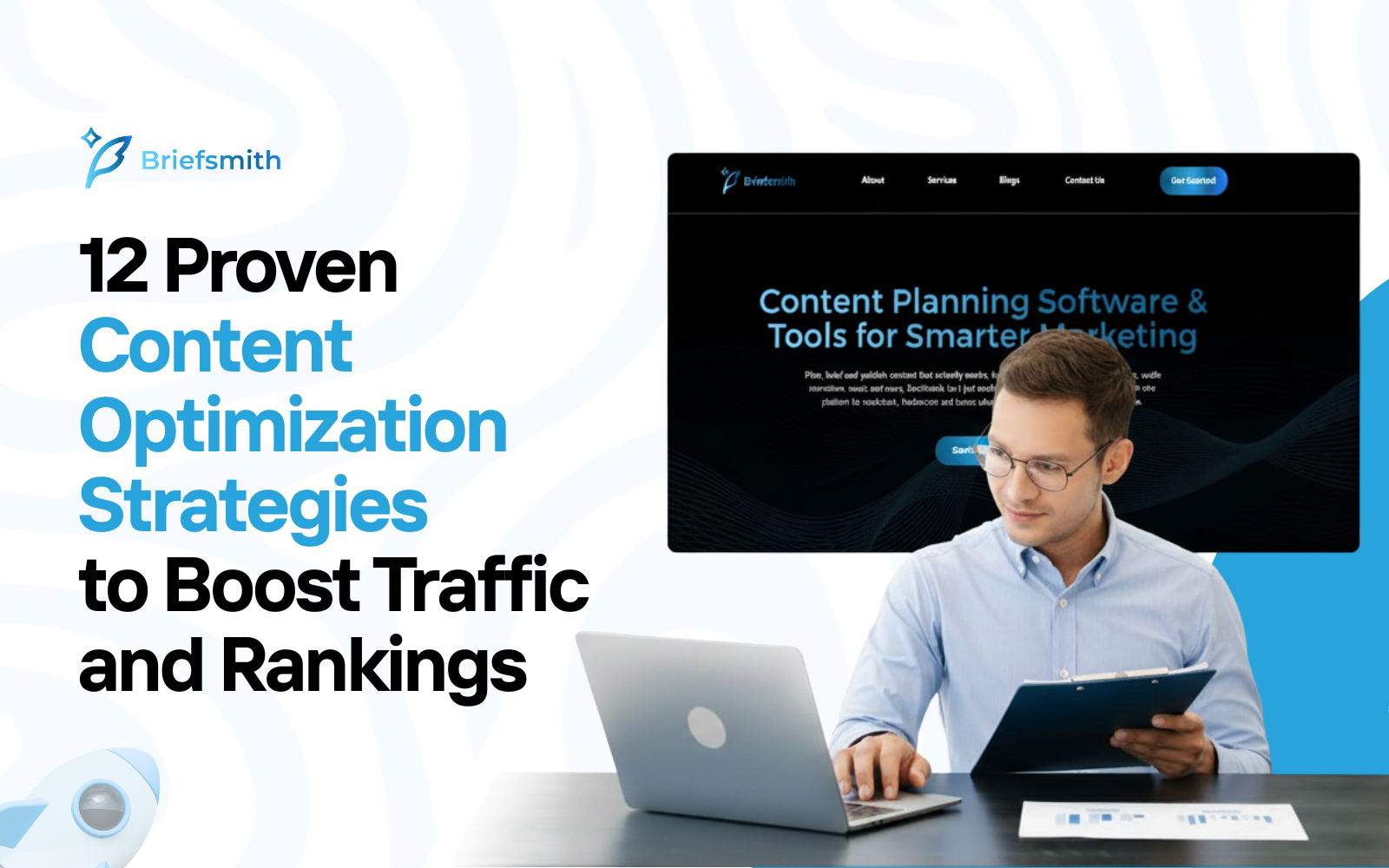SEO Content Brief: A Complete Step-by-Step Guide for Marketers

Marketers love structure almost as much as results. And in 2025, structure means one thing. A killer SEO content brief.
If your team’s still brainstorming in Slack threads and guessing keywords in Google Docs, it’s time for an upgrade. The content game has changed, and the way you plan your posts should too.
This guide will walk you through how to build an SEO content brief that brings order, clarity, and serious ranking power to your marketing workflow.
What Exactly Is an SEO Content Brief?
Think of an SEO content brief as your creative roadmap that equal parts strategy and storytelling. It’s a single document that tells your writer (or team) everything they need to produce content that ranks and resonates.
A well-built brief covers:
- Target keywords and intent
- Ideal audience
- Key talking points
- Structure and headings
- Links, tone, and calls to action
It’s the secret weapon behind high-performing blogs, landing pages, and resource hubs. Without it, your content can feel scattered. Pretty, but purposeless.
For marketers, a brief isn’t just a checklist. It’s alignment in written form. It keeps everyone; strategists, SEOs, writers, and designers on the same page and moving in the same direction.
Why Every Marketing Team Needs a Brief
A structured SEO content brief for marketers solves a thousand invisible problems. It prevents writers from guessing your intent, keeps brand voice consistent, ensures your content fits into your SEO strategy and not just next week’s publishing calendar.
Most importantly, it creates a repeatable process.
When you scale your content operation, you don’t want creativity to depend on who’s writing. You want results that are predictable and measurable. A strong brief turns chaos into systemized creativity.
And yes, it saves time. Something every marketer is running out of.
Step 1: Define Your Goal and Audience
Every good SEO brief starts with clarity. What’s the purpose of the content? Are you driving signups, building authority, or capturing search intent for a specific keyword?
Next, define your audience. Go beyond demographics. Dig into problems, goals, and behaviors. What’s frustrating them? What solution are they Googling at 10 p.m.?
The clearer your target, the sharper your message.
Pro tip: Include a short personal summary in your brief. A single paragraph like:
“Our reader is a marketing manager at a SaaS company, juggling content calendars and lead targets. They need actionable SEO guidance, not theory.”
That line alone gives writers focus.
Step 2: Do Smart Keyword Research
Here’s where strategy meets science. The best briefs don’t just include keywords, but they include intent-driven keywords.
Start with your primary keyword like in this case, “SEO content brief.”
Then add secondary keywords like “SEO content brief for marketers,” “content workflow for marketing teams,” and “collaborative content planning.”
Use a tool like Ahrefs, Semrush, or Briefsmith’s keyword research assistant to find search terms that hit the sweet spot between traffic and relevance.
Don’t chase volume blindly. A 300-search keyword with clear intent can outperform a vague 5,000-search one.
Once you have your list, map your keywords into headings and subtopics. This helps Google and your reader to understand your content flow.
For an extra layer of research strategy, check out Ahrefs’ Keyword Research Guide.
Step 3: Analyze What’s Already Ranking
You can’t beat the competition if you don’t understand it.
Search your main keyword in Google and scan the top 10 results and note the following:
-
- Common structures (listicles, guides, comparisons)
- Heading patterns
- Word count and tone
- Missing information or weak sections
Your brief should highlight what’s missing in the existing results because that’s your opportunity to stand out.
For example, if every competitor covers “what is an SEO content brief” but none explain “how to align briefs across teams,” that’s your angle.
Briefsmith’s automated competitor analysis can handle this step for you such as pulling insights, structure patterns, and topical gaps in seconds.
Step 4: Outline Your Content Structure
Now that you’ve got your goal, audience, and keywords, it’s time to outline.
A solid content workflow for marketing teams starts with structure. Every brief should include:
- Title & Meta Description: Clear, keyword-optimized, and click-worthy.
- Headings (H2, H3): Logical flow that builds authority and readability.
- Key Talking Points: Bullet the must-include ideas for each section.
- Internal & External Links: Support your content ecosystem and credibility.
- CTA Placement: Where and how you’ll prompt action.
Writers thrive with guardrails. They need room to create but direction to stay aligned.
Pro tip: Add an estimated word count for each section. It helps to balance depth and pacing.
Step 5: Add Optimization Details
Your SEO content brief isn’t complete without an SEO content optimization process.
Include specifics like:
-
- Primary and secondary keyword placement (title, intro, H2s, conclusion)
- Recommended internal links
- Image alt-text suggestions
- Snippet opportunities (FAQs, lists, comparisons)
Optimization isn’t just about keywords. It’s about experience. Google now rewards content that answers questions fast, formats neatly, and reads naturally.
Make readability a rule, not a suggestion. Short sentences, subheadings, and generous white space keep users engaged and bounce rates low.
Step 6: Make It Collaborative
A collaborative content planning process is what turns briefs into living systems.
Too many marketing teams treat briefs like static PDFs. They hand them off and hope for the best. Instead, use tools (like Briefsmith) that let strategists, writers, and editors collaborate in real time.
Comment threads, keyword suggestions, and audio summaries make briefs dynamic not dusty.
When teams can co-edit and update briefs seamlessly, content production speeds up, quality improves, and feedback loops shrink from days to minutes.
Step 7: Review, Refine, Repeat
After publishing, don’t just move on. Track how your content performs.
Check keyword rankings, engagement metrics, and time on page. If a post isn’t performing, go back to your brief. Was the intent off? Were the keywords too broad? Did the structure bury the main value point?
Treat every brief as a living document. Over time, you’ll create a playbook of what works best for your brand and audience.
Content Brief Best Practices
To wrap it up, here are a few content brief best practices worth bookmarking:
-
- Keep your briefs concise so that you aim for clarity over complexity.
- Always include intent and audience notes, not just keywords.
- Use real data (SERPs, analytics, CRM insights) to inform briefs.
- Encourage creative flexibility since briefs guide, not dictate.
- Standardize templates so your team speaks a common content language.
And if your team is large or global, create brief templates by content type: blog, product page, or pillar post. One size rarely fits all.
Bonus: How Briefsmith Simplifies the Whole Process
Building SEO briefs manually takes hours. Briefsmith automates the heavy lifting.
You can:
- Generate keyword lists and SERP summaries instantly.
- Build content outlines in minutes.
- Share, comment, and edit briefs collaboratively.
- Repurpose content into narrated audio or social snippets.
In short, it’s everything marketing teams need for smarter, faster, and more strategic content planning minus the chaos of spreadsheets and sticky notes.
Final Thoughts
A great SEO content brief is more than a document. It’s the heartbeat of your marketing workflow. It’s a single source of truth that turns ideas into content that ranks, engages, and converts.
When built right, your brief doesn’t just tell writers what to create. Instead, it tells them why it matters. That’s where true marketing magic happens.
Ready to Build Briefs That Practically Write Themselves?
Stop juggling tools. Start publishing smarter.
Ensure you try Briefsmith — your all-in-one platform for SEO briefs, keyword research, and collaborative content planning.
Related: Why Content Planning Software Is the Secret Weapon for Modern Marketing Teams



